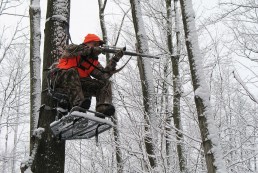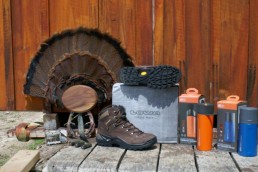Cold-weather Muzzleloading Tips: Keeping Gear Working in the Extremes
SHARE THIS POST
The morning air above the snow was crisp while I sat in my treestand, enjoying a December deer hunt. One avenue that grants hunters access to additional gun seasons is muzzleloading.
Muzzleloaders have jumped in popularity over the last two decades. Advancements in technology and design have made them much easier to use and more accurate. Another huge bonus is the additional hunting opportunities in the form of late-season controlled hunts or muzzleloading only seasons.
Decorated author of several muzzleloading books, Toby Bridges is one of the sport’s strongest advocates.
“There are roughly 3.5 million muzzleloading hunters currently in North America,” Bridges said.
His research indicates that hunter numbers were increasing dramatically until six years ago. Now, the trend has leveled off, but is expected to climb again as more black powder seasons open throughout the continent.
Venturing out into the late-season woods, it’s expected to meet frigid temperatures and snow. However, damp and rainy conditions have now become the norm. And moisture is the enemy of muzzleloaders and keeping gear dry becomes a battle. Even the most modern black powder substitutes are doomed when damp. Several precautions can be taken to avoid problems while enjoying late-season hunting.
Moisture is the enemy
Fluctuating temperatures and humidity play havoc with powder. Transporting between home, vehicle and field is the culprit. As your gear—especially the gun—warms and cools, condensation occurs. The easiest fix is keeping gear locked in the vehicle or in an unheated garage overnight. Keeping it acclimated to the cold nixes moisture buildup. I am still uncomfortable with this procedure, but it reduces moisture seeping into the gun’s action. Come morning, your gun will be icy-cold, but knowing it’s bone-dry will warm your heart. Remember, once the primer is removed, a muzzleloader is legally considered unloaded—you can safely and legally store it loaded with a bullet and powder for days at a time. Traveling hunters are always advised to check state and provincial firearm storage and transportation laws regarding what is legal in the area.
Are you enjoying this post?
You can be among the first to get the latest info on where to go, what to use and how to use it!
The alternative is to clean the gun after every outing. Cleaning and loading should be done in the driest of sites, and indoors is best for performing this duty. Dissipate any moisture and allow the action, breech plug and barrel to dry. It will take time, but nothing is more horrid than the gun not going pop! This is not a newsflash for seasoned hunters, but consistent and methodical cleaning will ensure ignitions.
Powder flasks or quick-reloading tubes need care too. Glass flasks can fog up, so care for them exactly like your firearm. Ensure they’re totally dry before filling and avoid sudden temperature fluxes. Plastic might be a better option to consider.
Break-open guns are currently the best at keeping the ignition system dry and protected. Traditional arms and even bolt-action or inline models tend to need more care. Avoid contact with anything wet, including damp brushes or clothing or blind material that will transmit moisture. A quick rub with an absorbing chamois is great for cleaning up any drips in the field.
Tape it
One slick trick to prevent anything entering the barrel is to apply a sliver of electrical tape over the muzzle. At first I was anxious covering the muzzle, but after testing at the range, I determined that my groupings were unaffected. A single strip of tape placed over the opening is all that’s needed. Another wrap or two of tape around the barrel will hold the first piece of tape in place. Tape doesn’t stick to stainless or Weatherguard- coated barrels well, so a few extra wraps might be needed. Barrel nipples are available if tape seems crude. You’ll need a large front blade to secure the nipple, but this will impede your aim if your gun in not scoped. Tape is the easiest and cheapest in the long run.
Once you’ve got the gun spot on make sure you’re ready to take the shot. Practice with all winter gear on in the offseason. I learned the hard way that my bulky glove couldn’t fit into the trigger guard. The few panicked seconds to free myself was all it took for the deer to melt into the cedars.
One strategy for keeping gear dry is hiding indoors. Being comfortable, concealed and dry is always more fun, and pop-up blinds make it easy. It’s also great for keeping everything dry and in perfect working order.
Muzzleloading grants hunters opportunities in the late season. Being prepared and maintaining the firearm in top working order will keep the gear ready for when you need it.
Did you enjoy this post?
You can be among the first to get the latest info on where to go, what to use and how to use it!
Luigi De Rose
Luigi De Rose, has been crafting articles for the last 25 years. Loving anything fishing, especially bass fishing, Luigi has been lucky enough to fish on three continents. Currently, he is the bass editor at Ontario OUT of DOORS magazine and owner of IBASSIN.com, a blog decided to all things bass. His articles have graced the pages of Bassmaster, In-Fisherman and MidWest Outdoors to name a few. When not fishing, you can find him with his two girls and wife in the outdoors.


